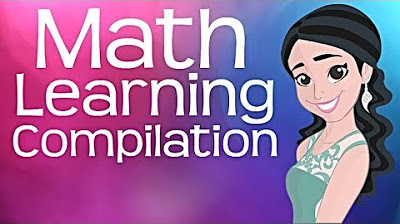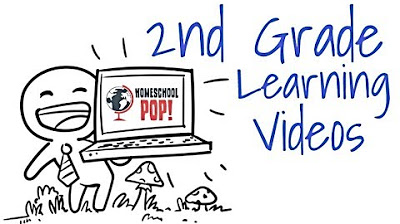Kindergarten Kids Learning Videos Compilation
TLDRThis educational video script introduces a variety of fundamental concepts in a fun and interactive manner. It covers topics such as recognizing equal parts, units of time including seconds, minutes, and hours, basic mathematical operations like addition and subtraction, identification of 2D and 3D shapes, and understanding the concept of even and odd numbers. The script also delves into geography by teaching about the seven continents and the five oceans of the world. Furthermore, it explores the intriguing Roman numeral system, offering a unique and historical perspective on numbers. The lesson is designed to be engaging, using a mix of humor, quizzes, and real-world examples to solidify learning.
Takeaways
- 🍕 The concept of 'equal parts' refers to dividing something into portions that are all the same size.
- 🕒 Time units include seconds, minutes, and hours, with seconds being the smallest, minutes 60 times larger than seconds, and hours being the largest.
- 🐶 A second is an extremely short unit of time, comparable to the time it takes a dog to jump or a cat to blink.
- 🧩 Addition is the process of putting numbers together, such as adding one golf ball to another to find the total number.
- 📏 2D shapes include circle, oval, triangle, square, rectangle, pentagon, hexagon, octagon, and more, each with distinct properties.
- 🎲 3D shapes like the sphere, cone, pyramid, cylinder, cube, and rectangular prism have depth and are the three-dimensional versions of their 2D counterparts.
- ⏰ Subtraction is the process of taking numbers away, such as giving away hats and calculating how many remain.
- 🌏 The Earth is divided into seven continents: North America, South America, Europe, Africa, Asia, Australia, and Antarctica, each with unique characteristics.
- 📚 Learning can be fun and engaging through interactive games and activities, making the process enjoyable and memorable.
- 🎵 Rhyming words are those that end in the same sound, an important aspect of language and poetry.
- 🔢 Even and odd numbers can be identified by their divisibility by two, with even numbers forming pairs and odd numbers having a remainder when divided by two.
Q & A
What is the main topic of the video?
-The main topic of the video is to teach various educational concepts such as equal parts, units of time, addition, subtraction, 3D shapes, continents, rhyming words, even and odd numbers, and Roman numerals in a fun and interactive way.
How does the video explain the concept of equal parts?
-The video explains equal parts by using the example of a pizza divided into equal sections, where each section is the same size, indicating that the parts are equal.
What are the three main units of time discussed in the video?
-The three main units of time discussed in the video are seconds, minutes, and hours.
How is the concept of addition introduced in the video?
-The concept of addition is introduced through the story of a character named Sally who collects golf balls, and the number of golf balls she has is increased by adding the new ones she finds.
What is the relationship between a 2D shape and its corresponding 3D shape as explained in the video?
-The video explains that a 3D shape is the three-dimensional version of a 2D shape. For example, a cube is the 3D version of a square, and a sphere is the 3D version of a circle.
How does the video use the scenario of giving away hats to teach subtraction?
-The video uses a scenario where the host starts with eight hats and decides to give some away. Each time a hat is given away, one is subtracted from the total count, demonstrating the concept of subtraction.
What are the seven continents of the world according to the video?
-The seven continents of the world, as mentioned in the video, are North America, South America, Europe, Africa, Asia, Australia, and Antarctica.
How does the video help in understanding the difference between even and odd numbers?
-The video uses the example of groups of dinosaurs to explain even and odd numbers. If the dinosaurs can be paired up into groups of two, the number is even; if there is a dinosaur left without a pair, the number is odd.
What are the five oceans of the world as taught in the video?
-The five oceans of the world taught in the video are the Arctic Ocean, the Atlantic Ocean, the Pacific Ocean, the Indian Ocean, and the Southern Ocean.
How does the video simplify the learning of Roman numerals?
-The video simplifies the learning of Roman numerals by introducing the basic symbols (I for 1, V for 5, X for 10) and then demonstrating how to combine them to represent other numbers. It also teaches special numerals for four (IV) and nine (IX).
Outlines
🍕 Learning About Equal Parts with Pizza
The video begins with an introduction to the concept of equal parts, using the example of sharing a pizza among four people. It explains how to recognize if parts are equal by checking if they are the same size. The video includes a fun activity to determine if various shapes are divided into equal or unequal parts.
⏱ Understanding Units of Time
The second segment discusses the three main units of time: seconds, minutes, and hours. It uses cute animals and simple examples to illustrate the duration of a second, emphasizing its brevity. The video also explains the abbreviations for seconds (sec or s).
⏳ Exploring Minutes and Hours
The video continues with a detailed explanation of minutes and hours. It demonstrates how a minute consists of 60 seconds and uses examples like blowing bubbles and taking short breaks to illustrate the concept. The segment also covers how hours are shown on clocks and their abbreviations (min for minutes, hr or h for hours).
➕ Introduction to Addition
This part introduces the concept of addition, explaining it as the process of putting numbers together. It uses a story about Sally collecting golf balls to demonstrate basic addition problems, such as 1 + 1, 2 + 2, and 4 + 3. The video highlights the simplicity and fun of addition.
➖ Learning About Subtraction
The next segment covers subtraction, defined as taking numbers away. Using a narrative about giving away cowboy hats, the video illustrates subtraction problems like 8 - 1, 7 - 2, and 5 - 3. It emphasizes the use of the minus sign and the ease of understanding subtraction through practical examples.
🔢 Introduction to 2D Shapes
The video reviews basic 2D shapes, such as circles, ovals, triangles, squares, rectangles, trapezoids, parallelograms, pentagons, hexagons, and octagons. It explains the properties of each shape and includes a quiz to reinforce the learning.
📐 Exploring 3D Shapes
This segment introduces 3D shapes like spheres, cones, pyramids, cylinders, cubes, and rectangular prisms. It explains the differences between 2D and 3D shapes, using everyday objects as examples. The video also includes a review of these shapes through a quick quiz.
🌏 Learning About Continents
The video explains the seven continents of the world: North America, South America, Europe, Africa, Asia, Australia, and Antarctica. It provides interesting facts about each continent, their locations on the map, and their unique characteristics.
🗺 Quiz on Continents
The segment includes a quiz to test the viewer's knowledge of the continents. The viewer is shown a map with a highlighted region and asked to identify the continent. The quiz reinforces the learning about the locations and features of the continents.
🔢 Roman Numerals and Counting
The final part of the video teaches Roman numerals, focusing on I, V, and X, which represent 1, 5, and 10, respectively. It demonstrates how to form other numbers using these numerals and includes a practice session counting from 1 to 30 in Roman numerals.
Mindmap
Keywords
💡Equal parts
💡Units of time
💡Addition
💡Three-dimensional shapes
💡Subtraction
💡Continents
💡Rhyming words
💡Even and odd numbers
💡Oceans
💡Roman numerals
Highlights
Introduction to recognizing equal or unequal parts through pizza sharing example.
Engaging game to visually identify if objects are divided into equal parts.
Explanation of units of time: seconds, minutes, and hours with relatable examples.
Cute animal demonstrations to understand the duration of a second.
Minute defined as 60 seconds with examples of everyday activities.
Introduction to the concept of addition as putting numbers together.
Golf balls scenario to illustrate the process of addition.
Introduction and review of 2D shapes before moving to 3D shapes.
Explanation of 3D shapes starting with the sphere and its characteristics.
Examples of real-life objects that are 3D shapes like cones and pyramids.
Hands-on approach to learning subtraction through a cowboy hat scenario.
Overview of the seven continents of the world and their unique features.
Interactive game to identify continents on a map.
Introduction to rhyming words and how to recognize them.
Teaching of even and odd numbers using a dinosaur grouping method.
Exploration of the five oceans of the world and their geographical locations.
Interactive game to name the oceans based on map illustrations.
Introduction to Roman numerals as an alternative way to write numbers.
Learning the basic Roman numerals I, V, and X representing 1, 5, and 10 respectively.
Combining Roman numerals to represent numbers and special numerals for four and nine.
Practice session going through the numbers 1 to 30 using Roman numerals.
Transcripts
Browse More Related Video
5.0 / 5 (0 votes)
Thanks for rating:





